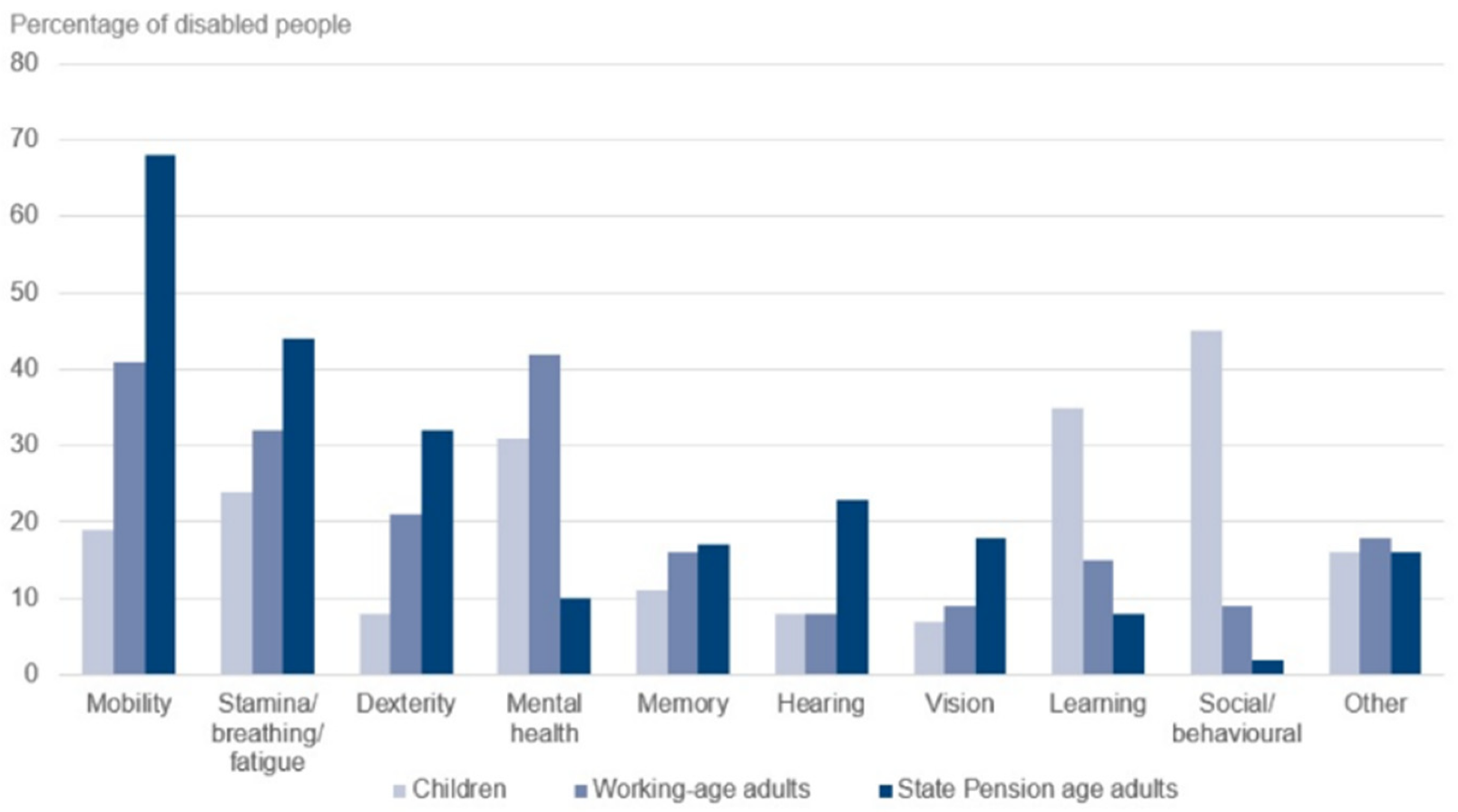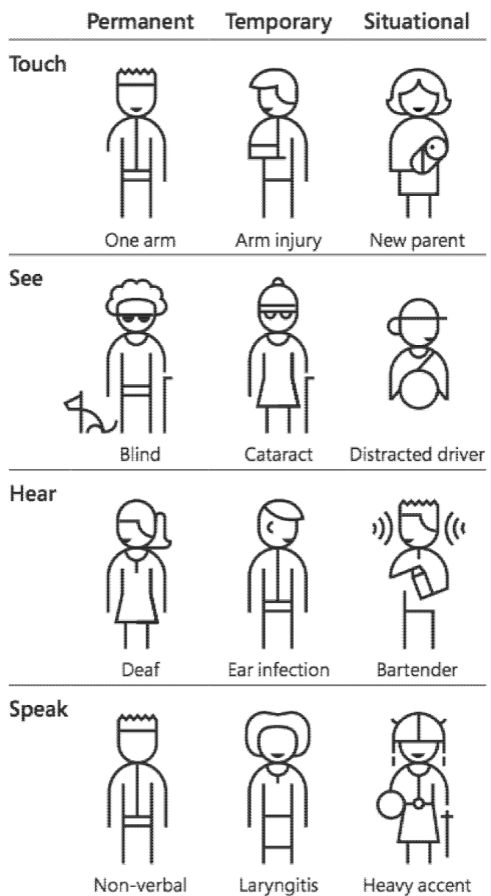
| Version | Summary | Created by | Modification | Content Size | Created at | Operation |
|---|---|---|---|---|---|---|
| 1 | Olivia Phoeby Narenthiran | -- | 1939 | 2022-04-20 10:14:21 | | | |
| 2 | Vivi Li | + 77 word(s) | 2016 | 2022-04-21 05:06:06 | | |
Video Upload Options
Accessible design within the built environment has often focused on mobility conditions and has recently widened to include mental health. Additionally, as one in seven are neurodivergent (including conditions such as ADHD, autism, dyslexia, and dyspraxia), this highlights a growing need for designing for ‘non-visible’ conditions in addition to mobility. Emphasised by the growing disability pay gap and the disability perception gap, people with disabilities are still facing discrimination and physical barriers within the workplace. To ensure the built environment contributes to an equal and inclusive society, people need to ensure their spaces are being designed to be accessible and inclusive. Successful integration of inclusive design within the design process contributes to the overall usability of the space, thus improving the overall sustainability of infrastructure. Similarly, by following the social model of disability, designers must aim to remove barriers experienced by the user, hence shifting the responsibility onto the designer to actively design a better space.
1. Introduction
‘If you do not intentionally, deliberately and proactively include, you will unintentionally exclude’.Jean-Baptiste [6].
2. Inclusive Design Applied in the Built Environment

‘The regulation is based on a medical conception of disability that assumes that the primary problem for disabled people, in gaining access to dwellings, resides with their impairment’.—Imrie [16]
3. Disability and the Workspace

‘The model says that people are disabled by barriers in society, not by their impairment or difference. Barriers can be physical, like buildings not having accessible toilets… removing these barriers creates equality and offers disabled people more independence, choice and control’.—Scope [19]
4. Workspace Design Considerations
‘For example, dropped kerbs, essential for wheelchair users, can confuse visually impaired people unless tactile surfaces or audio signals are incorporated’.—CEM [1]
5. Designing for a Spectrum of Needs
‘Designing with constraints in mind is simply designing well’.Shum et al. [41].

References
- CEM. Inclusive Access, Sustainability and the Built Environment; College of Estate Management: Reading, UK, 2010.
- John Clarkson, P.; Coleman, R. History of inclusive design in the UK. Appl. Ergon. 2015, 46, 235–247.
- Menezes, K.; de Oliveria Smith, P.; Woodworth, A.V. Programming for Health and Wellbeing in Architecture; Menezes, K., Ed.; Routledge: London, UK, 2014; Volume 37, ISBN 9780367758844.
- Channon, B. Happy by Design; RIBA Publishing: London, UK, 2019; ISBN 9781000726725.
- IWBI. WELL Building Standard Version 1. Delos International Well Building Institute. 2014. Available online: https://resources.wellcertified.com/tools/well-building-standard-v1/ (accessed on 1 October 2021).
- Jean-Baptiste, A. Making Inclusive Design a Priority. 2020. Available online: https://www.porchlightbooks.com/blog/changethis/2020/making-inclusive-design-a-priority (accessed on 11 April 2021).
- Greco, A. Social sustainability: From accessibility to inclusive design. EGE Rev. Expresión Gráfica Edif. 2020, 12, 18–27.
- Afacan, Y.; Afacan, S.O. Rethinking social inclusivity: Design strategies for cities. Proc. Inst. Civ. Eng. Urban. Des. Plan. 2011, 164, 93–105.
- Heylighen, A. Sustainable and inclusive design: A matter of knowledge? Local Environ. 2008, 13, 531–540.
- Mosca, E.I.; Capolongo, S. Universal Design-Based Framework to Assess Usability and Inclusion of Buildings. Lect. Notes Comput. Sci. (Subser. Lect. Notes Artif. Intell. Lect. Notes Bioinform.) 2020, 12253, 316–331.
- Mosca, E.I.; Herssens, J.; Rebecchi, A.; Capolongo, S. Inspiring architects in the application of design for all: Knowledge transfer methods and tools. J. Access. Des. All 2019, 9, 1–24.
- Brambilla, A.; Lindahl, G.; Dell’Ovo, M.; Capolongo, S. Validation of a multiple criteria tool for healthcare facilities quality evaluation. Facilities 2021, 39, 434–447.
- Bertram, T.; Pascal, C. Summary of Key Findings; Springer: Berlin/Heidelberg, Germany, 2016.
- Soane, A. Independent Review of Building Regulations and Fire Safety—A damning report. Struct. Eng. J. Inst. Struct. Eng. 2018, 96, 20–21.
- Wylde, M.A. Building for a Lifetime: The Design and Construction of Fully Accessible Homes/Margaret Wylde, Adrian Baron-Robbins, and Sam Clark; Clark, S., Baron-Robbins, A., Eds.; Taunton Press: Newtown, CT, USA, 1994; ISBN 1561580368.
- Imrie, R. The role of the building regulations in achieving housing quality. Environ. Plan. B Plan. Des. 2004, 31, 419–437.
- DWP Family Resources Survey: Financial Year 2019 to 2020. Gov.Uk. 2020. Available online: https://www.gov.uk/government/statistics/family-resources-survey-financial-year-2019-to-2020/family-resources-survey-financial-year-2019-to-2020#disability-1 (accessed on 26 January 2022).
- Bewley, H.; George, A. Research Paper: Neurodiversity at Work; ACAS: London, UK, 2016.
- Dixon, S.; Smith, C.; Touchet, A. The Disability Perception Gap, Scope. 2018. Available online: https://www.scope.org.uk/campaigns/disability-perception-gap/ (accessed on 7 February 2022).
- Salvendy, G. Handbook of Human Factors and Ergonomics, 4th ed.; John Wiley and Sons: Hoboken, NJ, USA, 2012; ISBN 9780470528389.
- Littlefield, D. Good Office Design, 1st ed.; Riba Publishing: London, UK, 2019; ISBN 9781000705171.
- Kaarlela-Tuomaala, A.; Helenius, R.; Keskinen, E.; Hongisto, V. Effects of acoustic environment on work in private office rooms and open-plan offices—Longitudinal study during relocation. Ergonomics 2009, 52, 1423–1444.
- Id, K.S.; Pachilova, R. Differential perceptions of teamwork, focused work and perceived productivity as an effect of desk characteristics within a workplace layout. PLoS ONE 2021, 16, e0250058.
- Hirst, A. Settlers, vagrants and mutual indifference: Unintended consequences of hot-desking. J. Organ. Chang. Manag. 2011, 24, 767–788.
- Morrison, R.L.; Macky, K.A. The demands and resources arising from shared office spaces. Appl. Ergon. 2017, 60, 103–115.
- Staines, G.M. Universal Design: A Practical Guide to Creating and Re-Creating Interiors of Academic Libraries for Teaching, Learning, and Research, 1st ed.; Chandos Information Professional Series; Elsevier: Amsterdam, The Netherlands, 2012; ISBN 9781843346333.
- Li, L.H.; Wu, F.; Su, B. Impacts of Library Space on Learning Satisfaction—An Empirical Study of University Library Design in Guangzhou, China. J. Acad. Librariansh. 2018, 44, 724–737.
- Sadia, T. Exploring the Design Preferences of Neurodivergent Populations for Quiet Spaces. EngrXiv 2020.
- Bossaller, J.; Oprean, D.; Urban, A.; Riedel, N. A happy ambience: Incorporating ba and flow in library design. J. Acad. Librariansh. 2020, 46, 102228.
- Nonaka, I.; Konno, N. The concept of “Ba”: Building a foundation for knowledge creation. Calif. Manag. Rev. 1998, 40, 40–54.
- Csikszentmihalyi, M. Applications of Flow in Human Development and Education: The Collected Works of Mihaly Csikszentmihalyi; Springer: Dordrecht, The Netherlands, 2014.
- Csikszentmihalyi, M. The flow experience and its significance for human psychology. Optim. Exp. 2012, 15–35.
- Roberts, A.C.; Yap, H.S.; Kwok, K.W.; Car, J.; Soh, C.K.; Christopoulos, G.I. The cubicle deconstructed: Simple visual enclosure improves perseverance. J. Environ. Psychol. 2019, 63, 60–73.
- Rooney, C.; Hadjri, K.; Mcallister, K.; Rooney, M.; Faith, V.; Craig, C. Experiencing visual impairment in a lifetime home: An interpretative phenomenological inquiry. J. Hous. Built Environ. 2018, 33, 45–67.
- Mitchell, L. Designing Dementia-Friendly Outdoor Environments. Qual. Ageing Older Adults 2004, 7, 26–33.
- Belzunegui-Eraso, A.; Erro-Garcés, A. Teleworking in the context of the Covid-19 crisis. Sustainability 2020, 12, 3662.
- Gibaldi, C.; McCreedy, R.T.W. The Observed Effects of Mass Virtual Adoption on Job Performance, Work Satisfaction, and Collaboration. In Work from Home: Multi-Level Perspectives on the New Normal; Emerald Publishing Limited: Bingley, UK, 2021; pp. 3–20.
- OECD The future of remote work: Opportunities and policy options for Trentino. OECD Local Econ. Employ. Dev. Pap. 2021, 9–10, 25.
- Atlas CLoud. AtlasCloud Survey: Get Hybrid Working Done Introduction; Atlas Cloud: Newcastle, UK, 2020.
- Megahed, N.A.; Ghoneim, E.M. Antivirus-built environment: Lessons learned from Covid-19 pandemic. Sustain. Cities Soc. 2020, 61, 102350.
- Shum, A.; Holmes, K.; Woolery, K.; Price, M.; Kim, D.; Dvorkina, E.; Malekzadeh, S. Inclusive: A Microsoft Design Toolkit. M. Price etc. Microsoft Des. 2016, 32, 32.
- Raine, K.D.; Muhajarine, N.; Spence, J.C.; Neary, N.E.; Nykiforuk, C.I.J. Coming to consensus on policy to create supportive built environments and community design. Can. J. Public Health 2012, 103, S5–S8.
- Kerr, J.; Rosenberg, D.; Frank, L. The Role of the Built Environment in Healthy Aging: Community Design, Physical Activity, and Health among Older Adults. J. Plan. Lit. 2012, 27, 43–60.




